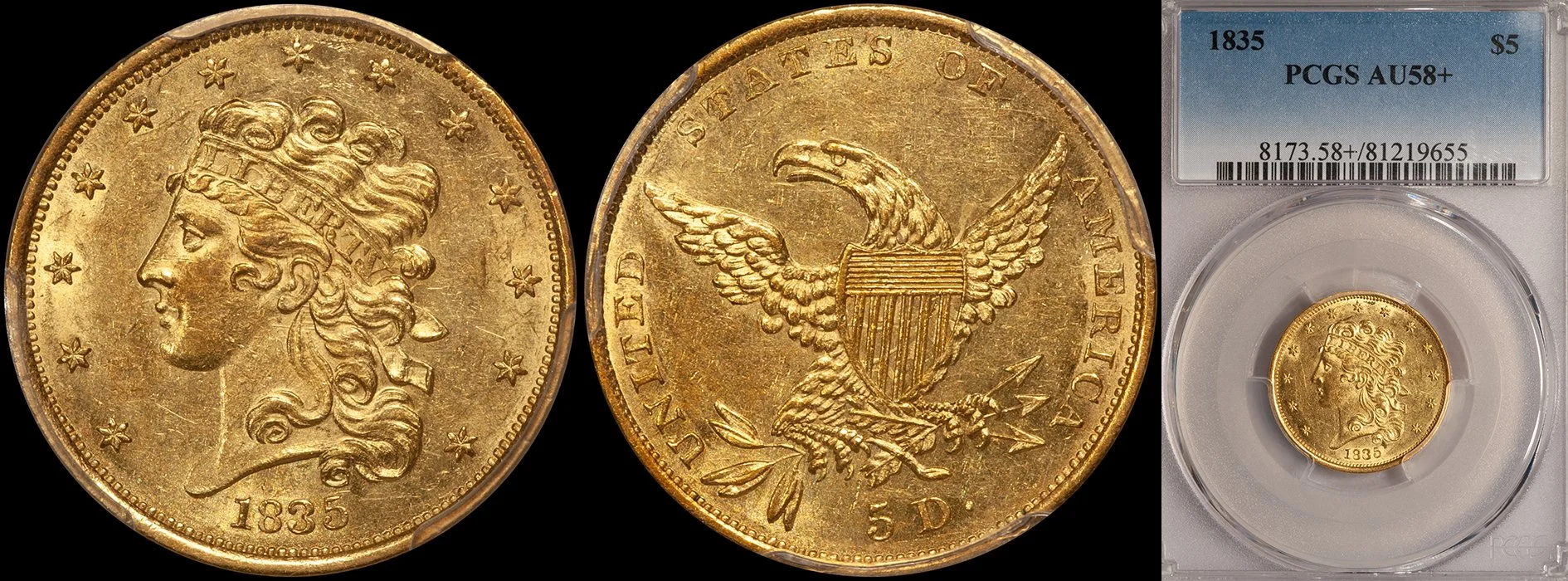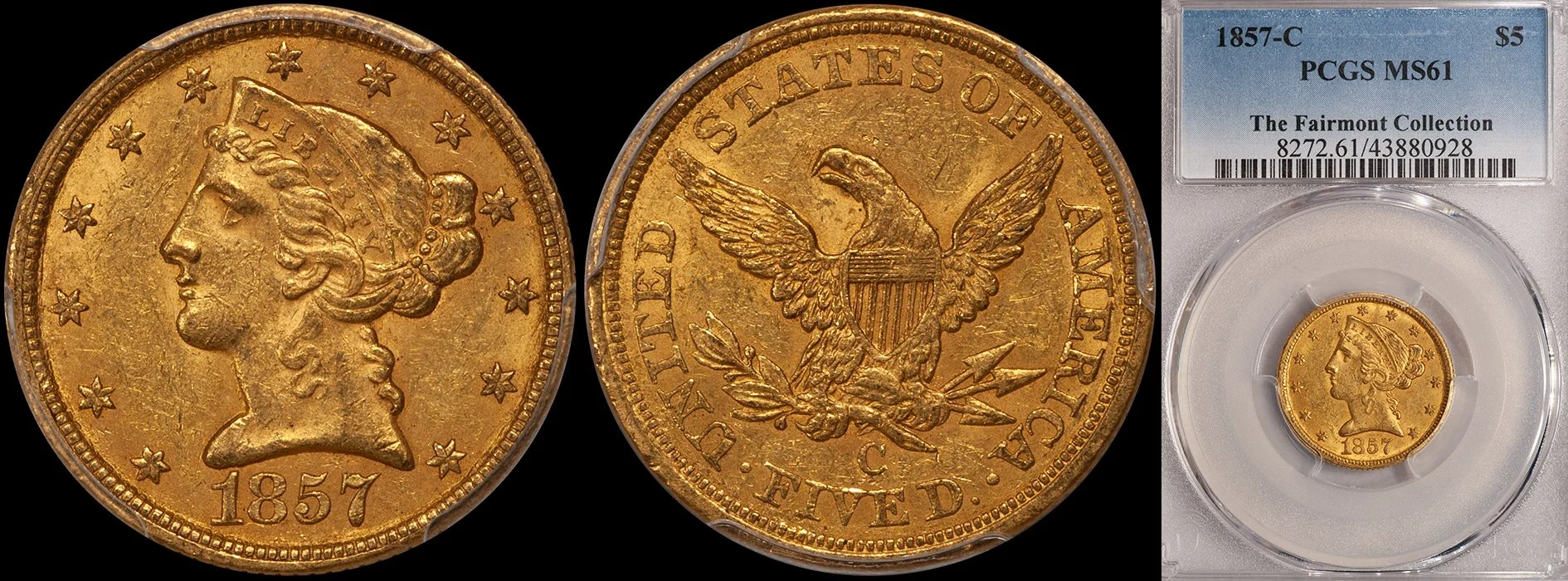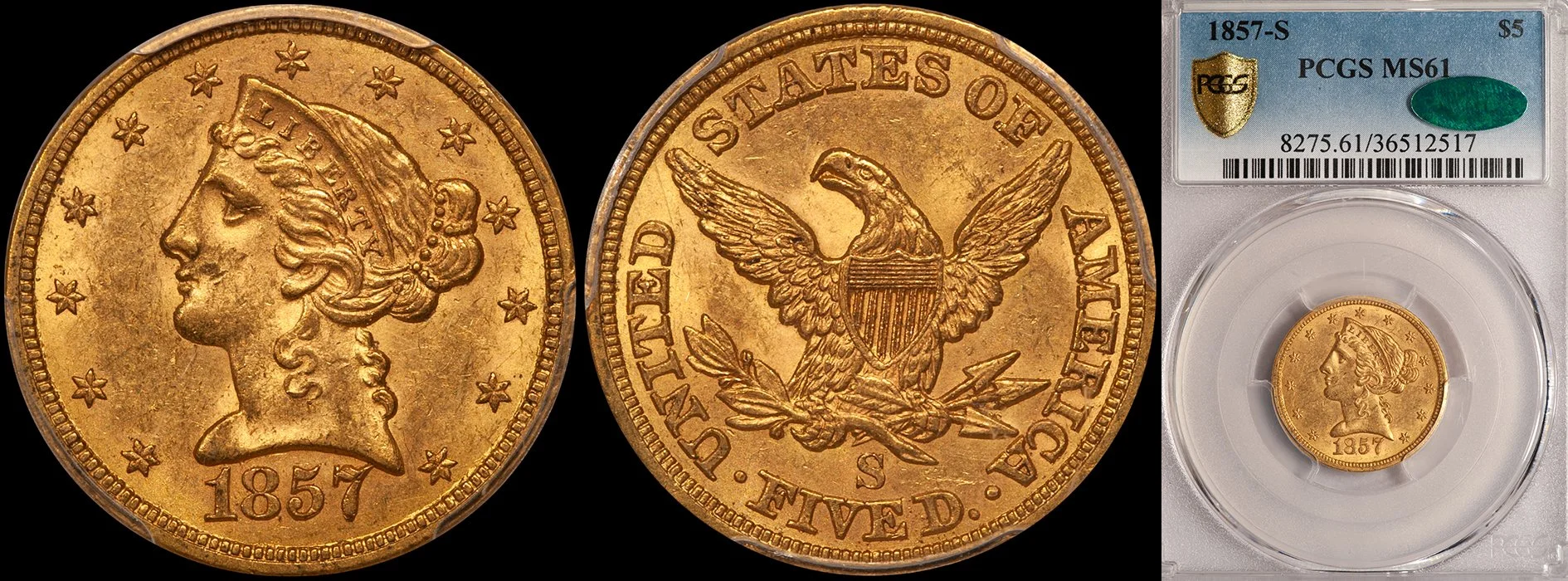A Dozen Undervalued United States Gold Coins Priced Below $7,500: The 2015 Edition
/It’s been quite a while since I wrote an article about the topic of affordable, undervalued 19th century U.S. gold coins, and I think it’s time to do a more current version of this article. I’m going to change things up ever so slightly this time and include some market overviews on each denomination, and make some suggestions which include multiple coins as opposed to “singles.”
1. 1864 Gold Dollar
I think I’ve done a good job at popularizing the formerly-undervalued 1863, and the last time I did one of these articles, I plugged the 1865. Which leaves the third of three tough Civil War issues, the 1864. Only 5,900 were struck and while a few exceptional pieces were clearly saved by contemporary collectors, most were either melted or saw duty in circulation.
1864 $1.00 PCGS MS63 CAC
Today there are likely under 200 examples known in all grades and I rank the 1864 as the third or fourth rarest P mint gold dollar, after the 1863 and 1875, and neck and neck with the 1865.
The most recent sale of an 1864 gold dollar (business strike) was a PCGS MS61 which brought $1,293 as Heritage 12/14: 1293; an exceptional value in my opinion. Current price levels for this issue remain affordable as an MS62 costs around $2,500, an MS63 is worth $4,250 or so and an MS64 will run around $6,000.
There are a number of other gold dollars which I think remain undervalued. I like the 1850-O, 1850-C and 1850-D in the Type One series. In Type Threes, I like all the San Francisco issues, the 1865 and the 1873 Closed 3.
2. 1837 Classic Head Quarter Eagle
I’m including this issue because I really like the Classic Head quarter eagle series as a source for good value. The 1834-1838 Philadelphia date run is affordable and very collectible, and it has the added advantage of some interesting die varieties as well.
The 1837 is more of an appearance rarity than a condition rarity. It is not really scarce at all in circulated grades but nearly every one I see in EF and AU has a crappy appearance due to poor strikes and mishandling. In original, choice AU grades, the 1837 is much scarcer than most collectors realize and it is excellent value at current levels.
The last really nice circulated 1837 quarter eagle I handled was from the Newman collection (ex Heritage 11/14: 3205, graded NGC AU58+, which sold for $3,055), and I can’t recall owning more than two or three CAC-quality examples over the last five or six years.
I’ve mentioned this before but Classic Head gold is intriguing to me as it represents a bridge between “old gold” and the more modern Liberty Head designs. Classic Head gold has clearly become more popular in the last few years and I foresee it becoming an avidly collected area sooner than later.
3. 1867 Quarter Eagle
I’ve been on the 1867 quarter eagle train for years, but there do not appear to be many other passengers on board as price levels for this date have remained pretty flat. I think this is primarily due to the fact that the few AU examples which have sold in the last five+ years have been doggy, and the only really nice piece I can recall having seen, ex Stacks Bowers 8/10: 1549, graded MS63 by PCGS, brought more money ($13,800) than the price range we are discussing in this article.
For most collectors, an AU55 to MS61 example of this date will be sufficient. CAC has approved just three for the date (AU53, AU55 and MS61) which shows that this date is an appearance rarity and well as being an undervalued condition rarity.
That said, for less than $5,000 you can—in theory—buy a nice 1867 quarter eagle.
There are many other Liberty Head quarter eagles priced below $7,500 which remain excellent value. I like nearly all of the 1840’s Philadelphia issues, especially the 1842. Virtually any Charlotte and Dahlonega quarter eagle in AU55 or AU58 with choice, natural color and unabraded surfaces is good value at current levels as are some of the low mintage issues from the 1880’s, especially the 1883 and 1884.
4. 1884 Three Dollars
A number of the Three Dollar gold pieces from the 1880’s have microscopic mintages but only two (the 1881 and 1884) are actually rare. The former date is priced out of range for the sake of this article but a nice 1884 is within reach of most gold collectors.
1844 $3.00 NGC AU58
Of the 1,000 struck for commerce, there are likely 200 or so 1884 Three Dollars known. This date is more often seen in Gem than circulated grades, so for the sake of the under-$7,500 budget, we should focus on examples in the AU58 to MS61 range. I’ve sold a few nice 58’s for around $4,000 and this seems like better value to me than an MS61 at around $6,000.
For the collector on a more modest budget, there are not all that many dates in the Three Dollar series which strike me as good value. I like the Civil War dates as they have multiple levels of demand and problem-free lower grade San Francisco issues of this type are harder to find than their price levels might suggest.
5. 1838-C Half Eagle
My comments from above regarding Classic Head quarter eagles hold true—if not more so—to half eagles of this type. The 1838-C might be a surprising choice for this list as many collectors don’t regard it as “undervalued.” I disagree; especially if the example in question is choice and original.
There are hundreds of 1838-C half eagles known (mostly in VF and EF grades) but probably fewer than 10% have nice surfaces and original color. CAC has only approved eight 1838-C half eagles in all grades (versus 17 for the 1838-D) with six of these in the VF-EF range. These numbers aren’t likely to change, meaning that prices for really nice VF and EF 1838-C half eagles seem to have nowhere to go but up.
For collectors with a budget of $1,500-3,000 per coin, I can think of fewer “old gold” issues with character than nice Classic Head half eagles and a date run of 1834-1838 Philadelphia issues should be given strong consideration.
6. 1842 Large Letters Half Eagle
This is another issue which I’ve raved about, on and off, for over a decade. Both this and its counterpart the 1842 Small Letters are rare and tremendously undervalued. The Small Letters is the scarcer of the two with around 50 known, mostly in the EF40 to AU50 range. While the PCGS population figures for AU’s is very low, prices remain affordable. As an example, Heritage 8/14: 3864, a nice PCGS AU55, sold for $4,700. This is a coin with a PCGS population of one in this grade with only four finer, yet it sold for less than $5,000. Load me up!
The reason for this coin being undervalued is, of course, the fact that it is a Philadelphia issue and not a glamorous southern branch mint coin. It has been said that P mint gold lacks the “sex appeal” of its counterparts and it’s hard to argue with this. But I’m seeing a lot more collectors become interested in these coins and I think the future looks bright for nice No Motto half eagles from the Philadelphia mint.
What are some of the other No Motto P Mint half eagles which I like? The list includes but is not limited to the 1842 Small Letters, 1846 Small Date, 1848, 1850, 1855, 1858, 1859 and 1860. Every one of these dates is well within your reach if your budget is $2,500-7,500 per coin.
7. 1876-S Half Eagle
Despite a tiny mintage of 4,000, this is a date which is overlooked. Collectors tend to be more focused on the No Motto half eagles from the San Francisco mint, and the With Motto coins are either forgotten scarcities or common issues which are desirable only in higher grades. There are an estimated 60-80 1876-S half eagles known, mostly in VF-EF grades. A single Uncirculated coin is known (graded MS64 by PCGS) and around a dozen properly graded AU’s.
For the collector with a budget of $2,500-7,500, an EF example of this date is certainly within reach. If available, a nice PCGS graded piece is likely to run in the $4,000-6,000 range.
For collectors with a budget of around $5,000 per coin, there are numerous No Motto and With Motto dates that I feel offer excellent value. These include the following: 1858-S, 1860-S, 1866-S Motto, 1867-S, 1873-S and 1894-S.
8. San Francisco eagles, dated 1854-1876
For my eighth selection, I’m not choosing a specific date but, rather, a specific group of coins: any choice, original eagle made at the San Francisco mint between 1854 and 1876. You’ll need to be at the top end of our $2,500-7,500 per coin basis to play but if you can afford these coins, you will get a ton of bang for your buck.
1855-S $10.00 PCGS EF45 CAC
Given the scarcity and the price, it isn’t practical to assemble a date run of SF eagles from this time period. I would suggest stretching for the right coins as they become available. With very few exceptions, the grade range you’ll be looking at is VF to EF which is actually a plus in this case as many San Francisco eagles of this era are actually more cosmetically appealing in EF40 than they are in AU50 to AU53.
The dates I suggest you keep an eye out for include the following: 1855-S, 1858-S, 1860-S, 1862-S, 1867-S, 1873-S and 1876-S.
9. 1854 Large Date Double Eagle
The Type One double eagle series is extensively collected and well-researched, so there aren’t a ton of sleepers left. The 1854 Large Date was one of two or three issues I thought about to represent this type, and I went with it over the 1855, 1856 and 1859 as it is rarer than the first two and easier to find than the 1859.
The 1854 Large Date was a mostly-unknown variety as recently as 15 years ago and while still comparatively scarce, dozens have been discovered either in Europe or from proper attribution of coins slabbed in the early 1990’s. It has become hard to find an 1854 Large Date priced at less than $7,500 but if you are patient, you may find a nice EF.
10. 1873 Closed 3 Double Eagle
This is an issue which suffers from the fact that its counterpart the 1873 Open 3 double eagle is exceedingly common. The 1873 Closed 3 is dozens of time scarcer and it is actually quite rare in Uncirculated with just two or three dozen known, mostly in the MS60 to MS61 range. I have never seen one finer than MS62 and only a few at this level.
Despite this coin’s rarity, it is still comparatively affordable. A PCGS MS61 just sold for $4,700 as Stack’s Bowers 2/15: 2629 and relatively nice AU coins can still be bought for $2,250-2,750.
For the collector with a budget of around $5,000 per coin, the Type Two series offers more value than either the Type One or Type Three double eagles. My favorite dates are the P mints from 1868 through 1871 and most of these can be found, with patience, for around $5,000 (or a touch more) for nice AU examples.
11. 1889 Double Eagle
Type Three Liberty Head double eagles tend to be rare (and very expensive) or common (and pretty boring). There are a few dates which fall into the scarce yet affordable category and among these is the 1889.
1889 $20.00 PCGS MS62 CAC
This date is very common in the lowest Uncirculated grades but it becomes scarce in MS62, rare in MS63, and it appears unknown (currently) in MS64.
Current price levels favor nice MS62 coins which are valued at around $4,000, while MS63’s more than triple in price.
Some runners-up in the Good Value Sweepstakes for Type Three $20 Libs. include the 1880, 1890, and 1902.
12. Virtually all Choice, Original gold coins in Uncirculated dated between 1840 and 1880
Our last choice is the broadest of the dozen, but it makes sense once I explain. If you think about it, why should nearly any U.S. gold coin made between 1840 and 1880 exist in any Uncirculated grade? Between meltings, financial crises, government seizures, and commercial usage, it is no wonder that so many gold coins from this era are either unknown or extremely rare in higher grades.
Yet many issues are available in nice MS61, MS62, and even MS63 grades for less than $7,500 per coin. Some of these dates are genuinely scarce in Uncirculated yet remain affordable. It seems to me that even a small spike in popularity could profoundly affect prices of subsets such as 1840’s quarter eagles, No Motto half eagles, and Type Two double eagles.
Do you have any comments or questions about this article? Please feel free to contact me via email at dwn@ont.com. Do you want to collect undervalued gold coins? Visit my website www.raregoldcoins.com or contact me directly to discuss your goals.


















